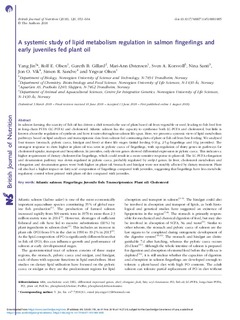| dc.contributor.author | Jin, Yang | |
| dc.contributor.author | Olsen, Rolf Erik | |
| dc.contributor.author | Gillard, Gareth B. | |
| dc.contributor.author | Østensen, Mari-Ann | |
| dc.contributor.author | Korsvoll, Sven A. | |
| dc.contributor.author | Santi, Nina | |
| dc.contributor.author | Vik, Jon Olav | |
| dc.contributor.author | Sandve, Simen Rød | |
| dc.contributor.author | Olsen, Yngvar | |
| dc.date.accessioned | 2019-01-30T11:41:10Z | |
| dc.date.available | 2019-01-30T11:41:10Z | |
| dc.date.created | 2018-09-05T14:50:23Z | |
| dc.date.issued | 2018 | |
| dc.identifier.citation | British Journal of Nutrition. 2018, 120 (6), 653-664. | nb_NO |
| dc.identifier.issn | 0007-1145 | |
| dc.identifier.uri | http://hdl.handle.net/11250/2583067 | |
| dc.description.abstract | In salmon farming, the scarcity of fish oil has driven a shift towards the use of plant-based oil from vegetable or seed, leading to fish feed low in long-chain PUFA (LC-PUFA) and cholesterol. Atlantic salmon has the capacity to synthesise both LC-PUFA and cholesterol, but little is known about the regulation of synthesis and how it varies throughout salmon life span. Here, we present a systemic view of lipid metabolism pathways based on lipid analyses and transcriptomic data from salmon fed contrasting diets of plant or fish oil from first feeding. We analysed four tissues (stomach, pyloric caeca, hindgut and liver) at three life stages (initial feeding 0·16 g, 2·5 g fingerlings and 10 g juveniles). The strongest response to diets higher in plant oil was seen in pyloric caeca of fingerlings, with up-regulation of thirty genes in pathways for cholesterol uptake, transport and biosynthesis. In juveniles, only eleven genes showed differential expression in pyloric caeca. This indicates a higher requirement of dietary cholesterol in fingerlings, which could result in a more sensitive response to plant oil. The LC-PUFA elongation and desaturation pathway was down-regulated in pyloric caeca, probably regulated by srebp1 genes. In liver, cholesterol metabolism and elongation and desaturation genes were both higher on plant oil. Stomach and hindgut were not notably affected by dietary treatment. Plant oil also had a higher impact on fatty acid composition of fingerlings compared with juveniles, suggesting that fingerlings have less metabolic regulatory control when primed with plant oil diet compared with juveniles. | nb_NO |
| dc.language.iso | eng | nb_NO |
| dc.publisher | Cambridge University Press | nb_NO |
| dc.title | A systemic study of lipid metabolism regulation in salmon fingerlings and early juveniles fed plant oil | nb_NO |
| dc.title.alternative | A systemic study of lipid metabolism regulation in salmon fingerlings and early juveniles fed plant oil | nb_NO |
| dc.type | Journal article | nb_NO |
| dc.type | Peer reviewed | nb_NO |
| dc.description.version | publishedVersion | nb_NO |
| dc.source.pagenumber | 653-664 | nb_NO |
| dc.source.volume | 120 | nb_NO |
| dc.source.journal | British Journal of Nutrition | nb_NO |
| dc.source.issue | 6 | nb_NO |
| dc.identifier.doi | 10.1017/S0007114518001885 | |
| dc.identifier.cristin | 1607000 | |
| dc.relation.project | Norges forskningsråd: 244164 | nb_NO |
| dc.relation.project | Norges forskningsråd: 248792 | nb_NO |
| dc.description.localcode | © The Authors 2018 | nb_NO |
| cristin.unitcode | 194,66,10,0 | |
| cristin.unitname | Institutt for biologi | |
| cristin.ispublished | true | |
| cristin.fulltext | original | |
| cristin.qualitycode | 1 | |
